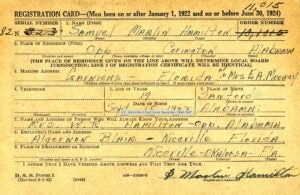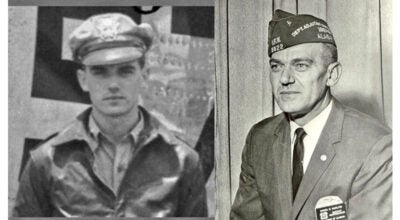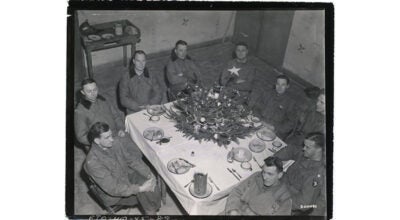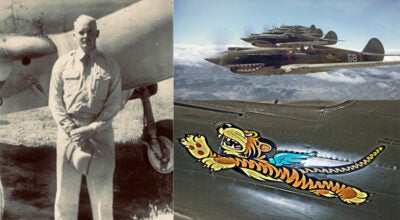COLUMN: Mission Over Munich – November 16, 1944 Samuel Marlin Hamilton, First Lieutenant, U.S. Army Air Force – WWII Part 1
Published 1:00 pm Friday, December 22, 2023
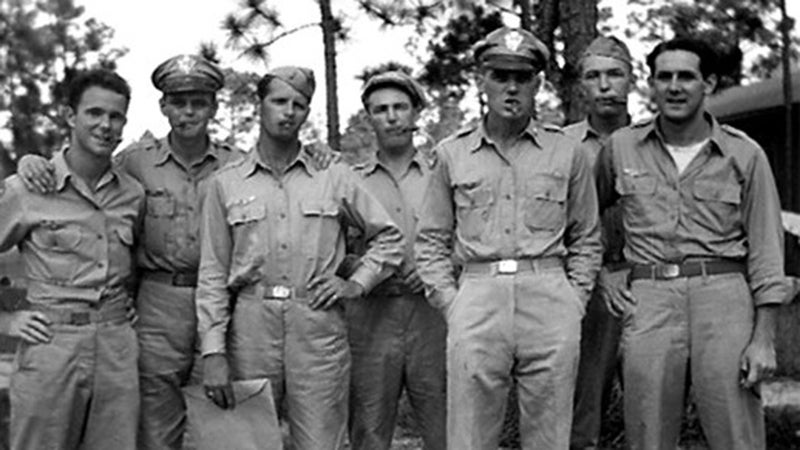
- Sam Hamilton and the crew of "The Opp Daily - Strictly Front Page." They are L-R, Hal Adams, Bo Barger, Joe Rudolph, John Murphy, Sam Hamilton, Tex Mattiza and Dick Weber. [Photo: Michael D. Weber]
|
Getting your Trinity Audio player ready...
|
On the morning of November 16, 1944, Sam Hamilton’s B-24 was the lead plane in the second attack group that took off from Spinazzola field in Foggia, Italy. Their target for the day was the railroad marshalling yards at Munich, Germany. Their plane was designated White L [for love] and was piloted by Captain Clifford W. Stone. The co-pilot was First Lieutenant Samuel M. Hamilton.
This would be the 10th mission for this air crew. Sam Hamilton had been the pilot on the first nine missions but was the co-pilot on this one so that Captain Stone could complete his 50th mission and go home.As the ship began its bombing run, it kept moving from side-to-side as the pilot tried to stay on course. A fellow pilot in a nearby bomber reported that once the bombs were away, the ship lurched sharply to the left. The plane’s speed suddenly slowed, causing the following planes to scatter. The plane also began losing altitude from about 26,000 feet.
The other planes in the formation tried to stay with the leader, but gave up when the plane passed through 15,000 feet. Yellow D was the aircraft flying on White Ls left wing and had been desperately trying to contact them on VHF. Suddenly, he heard, “Any ship in the Yellow Squadron, this is White L, please acknowledge.” The Yellow D pilot immediately acknowledged, saying, “Go ahead.” The reply came from White L, “I have two engines out, can’t hold altitude and am going down but want to get as far as possible.”
Samuel Marlin Hamilton was born on September 15, 1922, in the Wiggins community in Covington County, Alabama. His parents were Mary Edna “Mollie” Woodham and William Richard “Bud” Hamilton. The family farmed for a living. Marlin, as he was known by his family and friends, had three older siblings, William Aubrey, Annie Laurie and Percy Leon, and a younger brother, Robert Coleman.
The Hamilton family moved to Opp, Alabama, in 1936, where Marlin attended Opp schools. He graduated from Opp High School in 1940. He worked briefly with a construction company at Eglin Air Force Base, Florida, before enrolling at the University of Alabama in the fall of 1940. He joined the Army ROTC and worked on the staff of the student newspaper, The Crimson and White, while in college.
Shortly after the Pearl Harbor attack, Hamilton enlisted in the Army Air Force and was called to active duty on February 1, 1943. He was sent to the Army Air Force basic training base at Miami Beach, Florida. After completing basic, he was selected for the Army Aviation Cadet program and sent to the Army Air Forces Training Command at the University of Tennessee.
Hamilton completed five months training in the Aviation Cadet program, then underwent nine weeks of training as an Aviation Cadet at Maxwell Army Air Base in Montgomery, Alabama. After completing the pre-flight school at Maxwell, he was sent to Greenwood Army Air Field, Greenwood, Mississippi, for further flight training including navigation and night-flying.
After completing training at Greenwood, Hamilton received his Pilot’s Wings and was commissioned as a Second Lieutenant in the Army Air Corps. He was then sent for multi-engine training where he qualified as a B-24 Liberator bomber pilot.
Once qualified in the B-24, Hamilton was sent to Westover Field near Springfield, Massachusetts, where he was assigned a new plane and crew. Samuel “Sam” M. Hamilton was the pilot, Joe Rudolph was the co-pilot, Emmett W. ”Bo” Barger was the navigator, John Murphy was the bombardier, Robert “Bob” Seidel was the nose gunner, John Bills Jr., was the tail gunner, Harold “Hal” Adams was the flight engineer and top turret gunner, Otto “Tex” Mattiza was the left waist gunner, Richard “Dick Weber” was the right waist gunner and Delbert “Dana” Satterfield” was the ball turret gunner.
From Westover, Hamilton and his crew were sent to Chatham Field near Savannah, Georgia, for Combat Crew training. They arrived at Chatham around July 15, 1944. The training usually lasted several weeks. Flying the B-24 was a demanding job, requiring great physical exertion while constantly monitoring the myriad of gauges. Sam Hamilton and Joe Rudolph made a good team and gained the respect of their crew, preparing them for the coming combat missions.
In August, the plane and crew were ordered to Mitchell Field, New York, to prepare for their overseas trip. On August 26, Hamilton and his crew were assigned a brand-new B-24, serial number 42-50010. Hamilton wrote to his folks back home that the crew had decided to name the plane “The Opp Daily – Strictly Front Page,” in honor of his hometown and local newspaper. It is not known if the name was painted on the plane.
After enjoying the sights of New York for a few days, the crew reported to Grenier Field, New Hampshire. They remained there a few days before flying to Gander, Newfoundland, which was their final stop before going overseas. They learned that they had been assigned to the 15th Air Force but did not know the location nor name of their new squadron.
They departed Gander for the Azores but had to divert to Goose Bay, Labrador because of mechanical problems. After repairs, they left the next day for the Azores. After a brief stop there, they took off for Marrakesh, Morocco. A few days later, they left with sealed orders to be opened after takeoff. The new orders sent them to Tunis, Tunisia, which had been the headquarters for the 15th Air Force commanded by General Nathan F. Twining.
Tunisia was the last stop for the crew of the “Opp Daily -Strictly Confidential” before they arrived at their final destination, Gioia del Colle Airbase, about 35 miles north of Taranto. Hamilton and the crew were assigned to the 460th Bomb Group, 763rd Bomb Squadron, and ordered to fly to their new base at Spinazzola Field near Foggia, Italy. They were sad to learn that they had been given a new plane and had to leave the “Opp Daily – Strictly Confidential” behind. They arrived at Spinazolla Field, Foggia, Italy, on September 29 and were one of 24 replacement crews to arrive that month.
October was a bad time of the year to begin operations at Foggia. The rain and mud made it difficult to set up tents. There was no electricity, no floor for the tents and no heaters. The enlisted men managed to build a heater out of a steel drum, with another steel drum outside on a stand to allow fuel to flow inside. With some pilfered copper tubing and a shut-off valve, they managed to regulate the heating. They were eventually able to get power to the tent for a light bulb.
Sam Hamilton and Joe Rudolph were soon learning formation flying and combat tactics, sometimes without the rest of their crew onboard. It wasn’t long before they passed their check-out flights, making their crew ready for combat. On October 10, Hamilton and his crew learned they were to fly a combat mission the next day. The early morning briefing would be at 8:30 a.m.
[To be continued] John Vick
Author’s note: Sources will be given at the end of Part 2, however, the author would like to note that some material was sourced from the blog post, “The Story of The White For Love,” by Michael D. Weber, son of Richard “Dick” Weber, who was the waist gunner on Sam Hamilton’s B-24.


